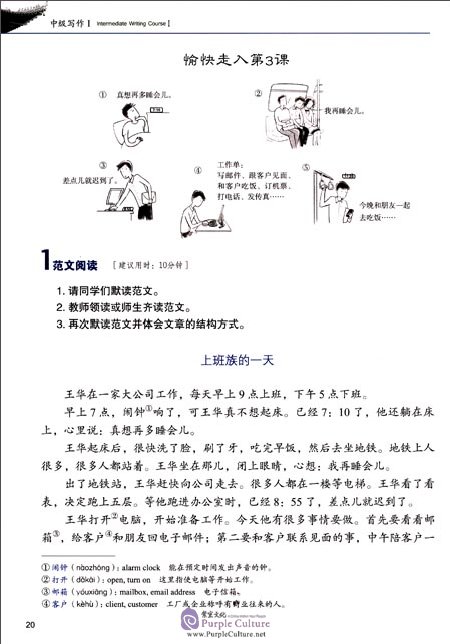Details
Usage Advice: It includes altogether 15 lessons, each of which is taught in two class periods.
Level: Intermediate
Developing Chinese (2nd Edition) is a set of nationally planned textbooks for higher education during the “Eleventh Five-Year”. Based on the well-designed structure of the first edition, this edition is in tune with the times, including 28 volumes with altogether 34 books.
Combining the cultivation of integrated language skills with the training of specific language skills in its compilation, it can be divided into three levels (elementary, intermediate and advanced) and five series (comprehensive, listening, speaking, reading and writing), among which the comprehensive series is the bulk and the others are the supportive series. The overall purpose is to develop and improve students’ Chinese language skills, Chinese communication skills, integrated Chinese capabilities as well as enhance their interest and ability in learning Chinese.
Developing Chinese (2nd Edition)—Intermediate Writing Course (I), following
Developing Chinese (2nd Edition)— Elementary Comprehensive Course (II) and
Developing Chinese (2nd Edition)—Elementary Reading and Writing Course(II), is designed for intermediate learners who have mastered 2000~2500 frequently-used Chinese words. It has altogether 15 lessons, including the following teaching procedures in class, i.e., “Comment and appraise the compositions written last time”, “Read the model composition”, “Analyze the model composition”, “Writing practice” and “Write a composition after class”, with each procedure providing the teaching time for teacher’s reference. Centering on the focus of the training of writing, each lesson provides a model composition with detailed and holistic analyses of the model composition and summarization of the key words or structures of the lesson. Through abundant writing practice, it teaches students to gradually master the key words or structures, and then carry out the writing tasks and improve their writing skills
About the Author
Cai Yongqiang is an Associate Professor of the School of Arts, Renmin University of China, Doctor of Arts, member of World Chinese Teaching Association, member of the Association of Chinese Sociolinguistics, member of Beijing Linguistics Association. He is the chief member of the writing committee of Developing Chinese (2nd Edition) and assumes the main responsibility in the design of the reading courses. He worked as a teacher in Aichi University of Japan from 2010 to 2011. His main research areas are modern Chinese and Teaching Chinese as a Foreign/Second Language, Lexicography of CFL (Chinese as a Foreign Language) and the international promotion of Chinese language. His academic works include Proceedings: International Workshop on Pedagogical Lexicology of CFL (one of the editors-in-chief) and The Localizer in Chinese and Its Conceptual System of Metaphors. He has published more than 30 academic papers, assumed the main responsibility or carried out the academic projects of Ministry of Education, Hanban and Overseas Chinese Affairs of the State Council. He has written the following textbooks: Chinese Fast Reading: A Step-by-Step Approach 4, Developing Chinese (2nd Edition) Intermediate Speaking Course II, and Developing Chinese (2nd Edition) Advanced Reading Course II, etc.
Sample Pages Preview

愉快走入第12课
1范文阅读
1.请同学们默读范文。
2.教师领读或师生齐读范文。
3.再次默读范文并体会文章的结构方式。
语言学家赵元任
赵元任(1892~1982)是中国江苏常州人,生于天津。他会说33种汉语方言,并精通②英语、法语、西班牙语、德语等多国语言,被称为“中国现代语言学之父”。凡是研究中国语言文学的人,几乎都读过赵元任的语言学著作。他的《中国话的文法》,在美国被认为是学习汉语语法最好的课本。
赵元任从小就表现出语言天才,各种方言一学就会。他掌握语言的能力非常惊人,能迅速掌握一种语言的声母、韵母和声调系统,并总结出使用规律。
赵元任一生最大的快乐,是到了世界任何地方,当地人都称他“老乡③”。
二战后,他到法国参加会议。在巴黎车站,他对工作人员讲巴黎的方言。对方听了,以为他是地道的巴黎人,于是说:“你回来了啊,现在可不如从前了,巴黎穷了。”
后来,他到德国柏林,用带柏林口音的德语和当地人聊天儿。邻居一位老人对他说:“上帝保佑,你躲过了这场灾难,平平安安地回来了。”
1920年,英国哲学家罗素(Russell)来中国演讲,赵元任当翻译。每到一个新地方,他都用当地的方言来翻译。他在去长沙的路上向湖南人学习长沙话,等到了长沙,已经能用长沙当地的方言翻译了。演讲结束后,竟有人跑来称呼他老乡。
赵元任说自己研究语言是为了“好玩儿”。在现代人看来,简单的一句“好玩儿”其实有很多深意。因为好玩儿不是功利主义,而是一种兴趣和爱好。
语言学是赵元任研究最深的领域,但他同时还给学生上物理课和逻辑课。赵元任也爱好音乐,写过一百多部音乐作品。
2 范文分析
1.解读范文《语言学家赵元任》。
(1)赵元任会说哪些语言?
(2)找出介绍赵元任语言学著作的语句。
(3)找出描写赵元任语言能力的语句。
(4)什么是赵元任一生最大的快乐?
(5)找出赵元任和巴黎人对话的语句。
(6)找出赵元任和柏林人对话的语句。
